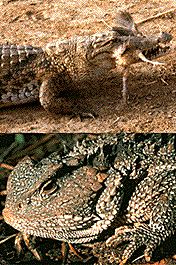Numerical phenetics

Numerical phenetics is a taxonomic school based upon the phenetic principle. It attempts to measure similarity using observable attributes of organisms. The school emphasizes quantitative techniques of measurement.
The simplest kind of numerical phenetic classification is defined by only one or two characters. The trouble with this procedure is that different individual characters show different distributions among species and therefore tend to produce different classifications. For example, crocodiles are more similar to reptiles like lizards and turtles than to birds if we look at their external surfaces (pictured opposite) and physiology; but crocodiles and birds have anatomically more similar skulls than either have with lizards and turtles. Classifying with a small number of phenetic characters, there is no way to decide which of the many classifications is the best.
Numerical pheneticists therefore recommend measuring as many characters as possible - even hundreds - and classifying according to the aggregate similarity for all of them. The more characters that are measured, the more likely it is that peculiar individual characters will be averaged out, and the better founded and more natural the classification will be.
| Next |



